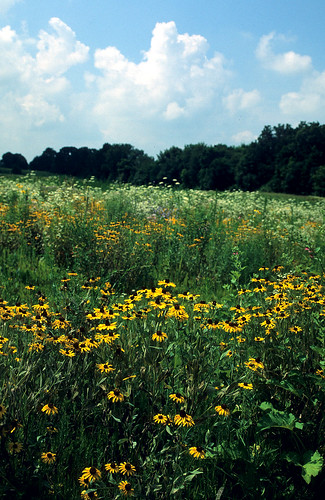
Thriving prairie with pollinator-friendly flowering plants, such as black-eyed susans, blooming.
James MacDonald owns 120 acres of rural land in Green County, Wisconsin. Through USDA’s Natural Resources Conservation Service (NRCS) Environmental Quality Incentives Program (EQIP), James expanded relic prairie on his land, including planting 3 acres of native pollinator mix through EQIP financial assistance. His prairie is in blossom all summer, with plants blooming at different times. “There are hundreds of prairie plants and they sort of pass off who’s in bloom, so from the end of the snow until the snow falls again there’s always something in bloom,” said James.
MacDonald says between his neighbors, there are about 100 hives within two miles of his property, so many bees use his prairie for food. James had a good idea of what bee-friendly mixes he wanted to plant so NRCS provided financial assistance, as well as technical assistance in site visits and checking to ensure his seed mix was adequate.
From June to September, the Midwest is where more than 65 percent of commercially managed honey bees in the country overwinter. It is a critical time when bees require abundant and diverse forage across broad landscapes to build up hive strength for the winter. “Their pollinator services impact about $15 billion worth of crop production in the U.S. every year,” said USDA−NRCS Resource conservationist Matt Otto. “One in three mouthfuls of our food come from crops impacted by bees, which need the health of bees to produce, so it’s vitally important to our agriculture.” You don’t have to own a lot of land to help out the bees. You can do your part to plant flowers and other pollinator-friendly plants at home to attract honey bees and help their population thrive.
EQIP assistance provided to landowners, like MacDonald, will provide guidance and support to farmers and ranchers to implement conservation practices that will provide safe and diverse food sources for honey bees. For example, appropriate cover crops or pasture management may provide quality forage and habitat for honey bees and other pollinators, as well as reduce erosion, increase the health of their soil, and inhibit invasive species.
“The 2014 Farm Bill keeps pollinators as a high priority, and these conservation efforts are one way NRCS is working to help this important species in Wisconsin,” Bramblett said.
USDA is providing more than $4 million in technical and financial assistance in FY 2015 to help farmers and ranchers in the Midwest improve the health of honey bees, which play an important role in crop production. Landowners, like James, can contact their local NRCS Service Center or visit www.wi.nrcs.usda.gov to learn more about NRCS programs, including pollinator and honey bee friendly restorations and planting efforts.
No comments:
Post a Comment
Note: Only a member of this blog may post a comment.